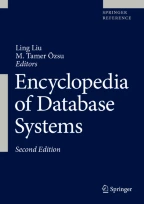Synonyms
Concurrency control; Preserving database consistency
Definition
A transaction is a logical unit of work that includes one or more database access operations such as insertion, deletion, modification, and retrieval [7]. A schedule (or history) S of n transactions T1,…,Tn is an ordering of the transactions that satisfies the following two conditions: (i) the operations of Ti (i = 1,…,n) in S must occur in the same order in which they appear in Ti, and (ii) the operations of Tj (j ≠ i) may be interleaved with Ti’s operations in S. A schedule S is serial if for every two transactions Ti and Tj that appear in S, either all the operations of Ti appear before all the operations of Tj or vice versa. Otherwise, the schedule is called nonserial or concurrent. Nonserial schedules of transactions may lead to issues with the correctness of the schedule due to concurrency such as lost update, dirty read, and unrepeatable read. For instance, the lost update problem occurs whenever two...
Access this chapter
Tax calculation will be finalised at checkout
Purchases are for personal use only
Recommended Reading
Bernstein PA, Goodman N. Multiversion concurrency control – theory and algorithms. ACM Trans Database Syst. 1983;8(4):465–83.
Bernstein PA, Hadzilacos V, Goodman N. Concurrency control and recovery in database systems. Reading: Addison-Wesley; 1987.
Dayal U, Hsu M, Ladin R. Business process coordination: state of the art, trends, and open issues. In: Proceedings of the 27th International Conference on Very Large Data Bases; 2001. p. 3–13.
Du W, Elmagarmid AK. Quasi serializability: a correctness criterion for global concurrency control in Interbase. In: Proceedings of the 15th International Conference on Very Large Data Bases; 1989. p. 347–55.
Eswaran KP, Gray J, Lorie RA, Traiger IL. The notions of consistency and predicate locks in a database system. Commun ACM. 1976;19(11):624–33.
Garcia-Molina H. Using semantic knowledge for transaction processing in a distributed database. ACM Trans Database Syst. 1983;8(2):186–213.
Gray J, Reuter A. Transaction processing: concepts and techniques. Los Altos: Morgan Kaufmann; 1993.
Gray J, Lorie RA, Putzolu GR, Traiger IL. Granularity of locks in a large shared data base. In: Proceedings of the 1st International Conference on Very Data Bases; 1975. p. 428–51.
Korth HF, Speegle GD. Formal model of correctness without serializability. In: Proceedings of the ACM SIGMOD International Conference on Management of Data; 1988. p. 379–86.
Mehrotra S, Rastogi R, Korth HF, Silberschatz A. Ensuring consistency in multidatabases by preserving two-level serializability. ACM Trans Database Syst. 1998;23(2):199–230.
Papadimitriou CH. The serializability of concurrent database updates. J ACM. 1979;26(4):631–53.
Papadimitriou CH. The theory of database concurrency control. Rockville: Computer Science; 1986.
Ramamritham K, Pu C. A formal characterization of epsilon serializability. IEEE Trans Knowl Data Eng. 1995;7(6):997–1007.
Sheth A, Leu Y, Elmagarmid A. Maintaining consistency of interdependent data in multidatabase systems. Technical Report CSD-TR-91-016, Purdue University. 1991. http://www.cs.toronto.edu/georgem/ws/ws.ps
Yannakakis M. Serializability by locking. J ACM. 1984;31(2):227–44.
Author information
Authors and Affiliations
Corresponding author
Editor information
Editors and Affiliations
Rights and permissions
Copyright information
© 2018 Springer Science+Business Media, LLC, part of Springer Nature
About this entry
Cite this entry
Ouzzani, M., Medjahed, B., Elmagarmid, A.K. (2018). Correctness Criteria Beyond Serializability. In: Liu, L., Özsu, M.T. (eds) Encyclopedia of Database Systems. Springer, New York, NY. https://doi.org/10.1007/978-1-4614-8265-9_722
Download citation
DOI: https://doi.org/10.1007/978-1-4614-8265-9_722
Published:
Publisher Name: Springer, New York, NY
Print ISBN: 978-1-4614-8266-6
Online ISBN: 978-1-4614-8265-9
eBook Packages: Computer ScienceReference Module Computer Science and Engineering
